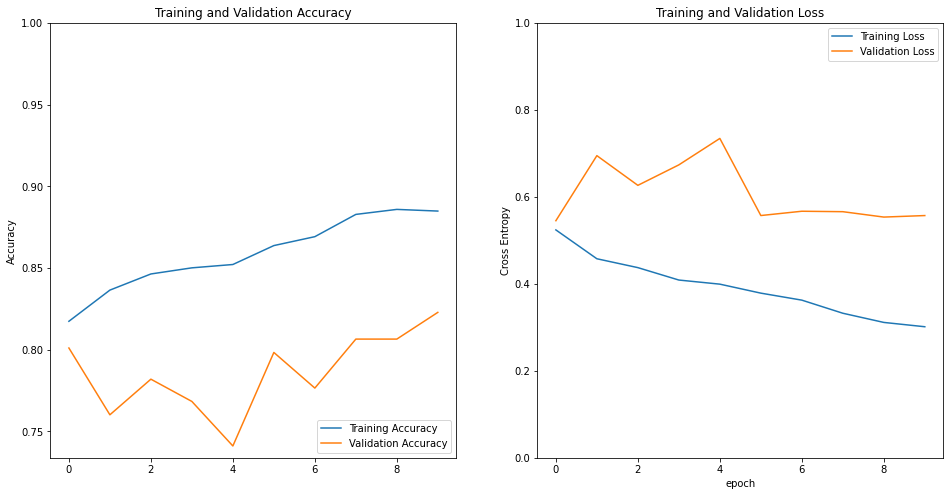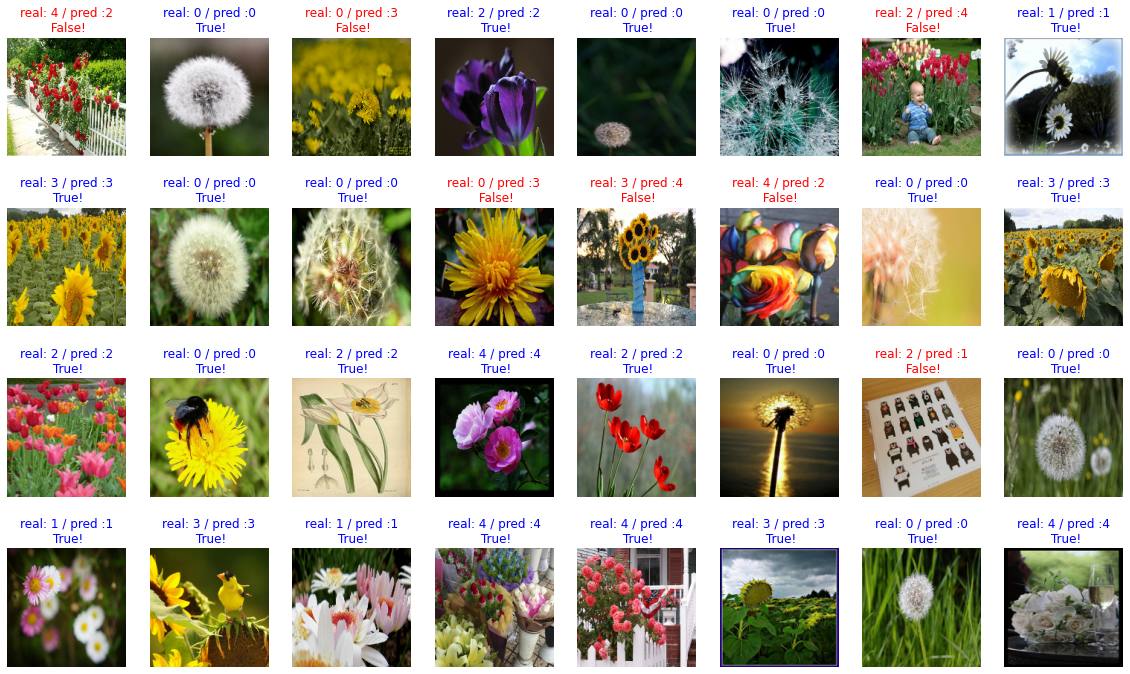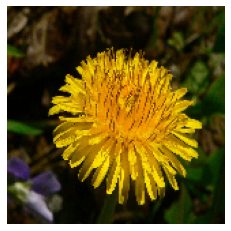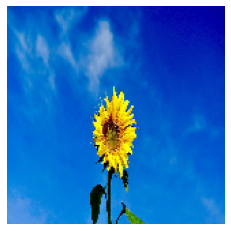프로젝트: 새로운 데이터셋으로 나만의 이미지 분류기 만들어보기
step1. 데이터셋 내려받기
import tensorflow as tf
import tensorflow_datasets as tfds
import matplotlib.pyplot as plt
tfds.__version__
'4.4.0'
(raw_train, raw_validation, raw_test), metadata = tfds.load(
'tf_flowers',
split=['train[:80%]', 'train[80%:90%]', 'train[90%:]'],
with_info=True,
as_supervised=True,
)
print(raw_train)
print(raw_validation)
print(raw_test)
['dandelion', 'daisy', 'tulips', 'sunflowers', 'roses']
<PrefetchDataset shapes: ((None, None, 3), ()), types: (tf.uint8, tf.int64)>
<PrefetchDataset shapes: ((None, None, 3), ()), types: (tf.uint8, tf.int64)>
<PrefetchDataset shapes: ((None, None, 3), ()), types: (tf.uint8, tf.int64)>
step2. 데이터셋을 모델에 넣을 수 있는 형태로 준비하기
- 이미지를 모두 같은 크기로 formatting한 후, train_batches, validation_batches, test_batches를 준비한다.
IMG_SIZE = 160
def format_example(image, label):
image = tf.cast(image, tf.float32)
image = image/255
image = tf.image.resize(image, (IMG_SIZE, IMG_SIZE))
return image, label
print("완료")
완료
train= raw_train.map(format_example)
validation = raw_validation.map(format_example)
test = raw_test.map(format_example)
print(train)
print(validation)
print(test)
<MapDataset shapes: ((160, 160, 3), ()), types: (tf.float32, tf.int64)>
<MapDataset shapes: ((160, 160, 3), ()), types: (tf.float32, tf.int64)>
<MapDataset shapes: ((160, 160, 3), ()), types: (tf.float32, tf.int64)>
plt.figure(figsize=(10, 5))
get_label_name = metadata.features['label'].int2str
for idx, (image, label) in enumerate(train.take(10)):
plt.subplot(2, 5, idx+1)
plt.imshow(image)
plt.title(f'label {label}: {get_label_name(label)}')
plt.axis('off')
---------------------------------------------------------------------------
AttributeError Traceback (most recent call last)
/tmp/ipykernel_2151/3504499461.py in <module>
4
5 get_label_name = metadata.features['label'].int2str
----> 6 print(metadata.features['label'].name)
7
8 for idx, (image, label) in enumerate(train.take(10)):
AttributeError: 'ClassLabel' object has no attribute 'name'
<Figure size 720x360 with 0 Axes>
Step 3. 모델 설계하기
- 모델은 어떤 방식으로 설계하고 싶은가요? 나만의 모델을 만들 것인가요, 아니면 base_model을 활용할 것인가요?
- 원하는 방식으로 모델을 만들어 보세요!
- cats_vs_dogs 의 경우와 달리, tf_flowers 데이터셋에서는 class의 갯수가 5가지입니다. 모델 설계시 어느 부분이 달라질지에 유의해 주세요
IMG_SHAPE = (IMG_SIZE, IMG_SIZE, 3)
model = tf.keras.applications.VGG16(input_shape=IMG_SHAPE,
include_top=False,
weights='imagenet')
model.trainable = False
global_average_layer = tf.keras.layers.GlobalAveragePooling2D()
dense_layer = tf.keras.layers.Dense(512, activation='relu')
prediction_layer = tf.keras.layers.Dense(5, activation='softmax')
base_model = tf.keras.Sequential([
model,
global_average_layer,
dense_layer,
prediction_layer
])
base_model.summary()
Model: "sequential_3"
_________________________________________________________________
Layer (type) Output Shape Param #
=================================================================
vgg16 (Functional) (None, 5, 5, 512) 14714688
_________________________________________________________________
global_average_pooling2d_3 ( (None, 512) 0
_________________________________________________________________
dense_10 (Dense) (None, 512) 262656
_________________________________________________________________
dense_11 (Dense) (None, 5) 2565
=================================================================
Total params: 14,979,909
Trainable params: 265,221
Non-trainable params: 14,714,688
_________________________________________________________________
for image_batch, label_batch in train_batches.take(1):
pass
image_batch.shape, label_batch.shape
(TensorShape([32, 160, 160, 3]), TensorShape([32]))
Step 4. 모델 학습시키기
- 모델을 학습시켜봅니다. 단, 여기에서는 여러 가지 옵션을 바꿔볼 수 있습니다.
- 예를 들어, 모델 학습을 10 epoch보다 더 많이 시켜보거나, learning_rate 값을 바꿔볼 수 있습니다.
- 또는, optimizer의 종류도 바꿔볼 수 있습니다. 바꿔보고 싶다면, 여기를 참고하세요.
- 어쩌면 VGG16이 아닌 다른 모델을 base model로 활용할 수도 있을 것입니다. 그리고 파인튜닝을 fc layer의 구성에 변화를 줄 수 있을지도 모릅니다.
- 이전 스텝에서는 시도하지 않았던 Regularization 기법이 적용된다면 어떨까요? Dropout이나 Batch Normalization을 적용하는 것은 그리 어려운 일이 아닙니다.
learning_rate = 0.001
base_model.compile(optimizer=tf.keras.optimizers.RMSprop(learning_rate=learning_rate),
loss=tf.keras.losses.sparse_categorical_crossentropy,
metrics=['accuracy'])
print("완료")
완료
BATCH_SIZE = 32
SHUFFLE_BUFFER_SIZE = 1000
print("완료")
완료
train_batches = train.shuffle(SHUFFLE_BUFFER_SIZE).batch(BATCH_SIZE)
validation_batches = validation.batch(BATCH_SIZE)
test_batches = test.batch(BATCH_SIZE)
print("완료")
완료
validation_steps= 10
loss0, accuracy0 = base_model.evaluate(validation_batches, steps = validation_steps)
print("initial loss: {:.2f}".format(loss0))
print("initial accuracy: {:.2f}".format(accuracy0))
10/10 [==============================] - 1s 68ms/step - loss: 0.5177 - accuracy: 0.8250
initial loss: 0.52
initial accuracy: 0.82
EPOCHS = 10
history = base_model.fit(train_batches,
epochs=EPOCHS,
validation_data=validation_batches)
Epoch 1/10
92/92 [==============================] - 8s 77ms/step - loss: 0.5240 - accuracy: 0.8174 - val_loss: 0.5452 - val_accuracy: 0.8011
Epoch 2/10
92/92 [==============================] - 8s 78ms/step - loss: 0.4577 - accuracy: 0.8365 - val_loss: 0.6948 - val_accuracy: 0.7602
Epoch 3/10
92/92 [==============================] - 8s 78ms/step - loss: 0.4373 - accuracy: 0.8464 - val_loss: 0.6265 - val_accuracy: 0.7820
Epoch 4/10
92/92 [==============================] - 8s 79ms/step - loss: 0.4087 - accuracy: 0.8501 - val_loss: 0.6736 - val_accuracy: 0.7684
Epoch 5/10
92/92 [==============================] - 8s 80ms/step - loss: 0.3993 - accuracy: 0.8522 - val_loss: 0.7344 - val_accuracy: 0.7411
Epoch 6/10
92/92 [==============================] - 8s 80ms/step - loss: 0.3786 - accuracy: 0.8638 - val_loss: 0.5571 - val_accuracy: 0.7984
Epoch 7/10
92/92 [==============================] - 8s 81ms/step - loss: 0.3625 - accuracy: 0.8692 - val_loss: 0.5670 - val_accuracy: 0.7766
Epoch 8/10
92/92 [==============================] - 8s 81ms/step - loss: 0.3324 - accuracy: 0.8828 - val_loss: 0.5659 - val_accuracy: 0.8065
Epoch 9/10
92/92 [==============================] - 8s 80ms/step - loss: 0.3113 - accuracy: 0.8859 - val_loss: 0.5535 - val_accuracy: 0.8065
Epoch 10/10
92/92 [==============================] - 8s 80ms/step - loss: 0.3014 - accuracy: 0.8849 - val_loss: 0.5570 - val_accuracy: 0.8229
Step 5. 모델 성능 평가하기
- 모델 학습이 완료되었다면, 모델의 성능을 평가할 차례입니다.
- 모델이 학습된 과정을 그래프로도 그려보고, validation_batches나 test_batches에 있는 데이터에 대한 예측 결과도 확인해 보세요!
acc = history.history['accuracy']
val_acc = history.history['val_accuracy']
loss = history.history['loss']
val_loss = history.history['val_loss']
plt.figure(figsize=(16, 8))
plt.subplot(1, 2, 1)
plt.plot(acc, label='Training Accuracy')
plt.plot(val_acc, label='Validation Accuracy')
plt.legend(loc='lower right')
plt.ylabel('Accuracy')
plt.ylim([min(plt.ylim()),1])
plt.title('Training and Validation Accuracy')
plt.subplot(1, 2, 2)
plt.plot(loss, label='Training Loss')
plt.plot(val_loss, label='Validation Loss')
plt.legend(loc='upper right')
plt.ylabel('Cross Entropy')
plt.ylim([0,1.0])
plt.title('Training and Validation Loss')
plt.xlabel('epoch')
plt.show()

import numpy as np
for image_batch, label_batch in test_batches.take(1):
images = image_batch
labels = label_batch
predictions = base_model.predict(image_batch)
pass
predictions = np.argmax(predictions, axis=1)
predictions
array([2, 0, 3, 2, 0, 0, 4, 1, 3, 0, 0, 3, 4, 2, 0, 3, 2, 0, 2, 4, 2, 0,
1, 0, 1, 3, 1, 4, 4, 3, 0, 4])
plt.figure(figsize=(20, 12))
for idx, (image, label, prediction) in enumerate(zip(images, labels, predictions)):
plt.subplot(4, 8, idx+1)
plt.imshow(image)
correct = label == prediction
title = f'real: {label} / pred :{prediction}\n {correct}!'
if not correct:
plt.title(title, fontdict={'color': 'red'})
else:
plt.title(title, fontdict={'color': 'blue'})
plt.axis('off')

count = 0
for image, label, prediction in zip(images, labels, predictions):
correct = label == prediction
if correct:
count = count + 1
print(count / 32 * 100)
78.125
Step 6. 모델 활용하기
- 모델이 꽤나 똑똑해졌다면, 이제 활용해볼 수 있습니다.
- 원하는 이미지를 자유롭게 모델에 입력해 보고, 어떤 예측 결과를 내는지 확인해 보세요!
import os
img_dir_path = os.getenv("HOME") + "/aiffel/flower/images"
os.path.exists(img_dir_path)
True
from tensorflow.keras.preprocessing.image import load_img, img_to_array
def show_and_predict_image(dirpath, filename, img_size=160):
filepath = os.path.join(dirpath, filename)
image = load_img(filepath, target_size=(img_size, img_size))
plt.imshow(image)
plt.axis('off')
image = img_to_array(image).reshape(1, img_size, img_size, 3)
predictions = (base_model.predict(image)[0])
prediction_idx = np.argmax((base_model.predict(image)[0]))
flower_lists = metadata.features['label'].names
print(f"This image seems {flower_lists[prediction_idx]} with {np.max(predictions) * 100}%.")
filename = 'daisy.jfif'
show_and_predict_image(img_dir_path, filename)
This image seems daisy with 100.0%.

filename = 'dandelion.jpg'
show_and_predict_image(img_dir_path, filename)
This image seems daisy with 100.0%.

filename = 'roses.png'
show_and_predict_image(img_dir_path, filename)
This image seems roses with 100.0%.

filename = 'sunflowers.jpg'
show_and_predict_image(img_dir_path, filename)
This image seems sunflowers with 99.99990463256836%.

filename = 'sunflowers.jpg'
show_and_predict_image(img_dir_path, filename)
This image seems sunflowers with 99.99990463256836%.






